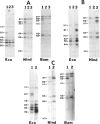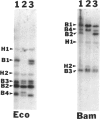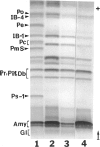Abstract
The PRB2/1 fusion gene is produced by homologous and unequal crossing-over between PRB1 and PRB2 genes that code for basic salivary proline-rich proteins (PRPs). To determine the molecular basis for the PRB2/1 fusion gene, the DNA sequence was determined for the PRB2/1 gene and was compared with those of the PRB1 and PRB2 genes. From these comparisons, the crossing-over is postulated to occur in a 743-bp region of identity, with only 1-bp mismatch between the PRB1 and PRB2 genes, in the third intron outside the coding region of the two genes. This region of virtual complete identity is the largest found between any of the six closely linked PRB genes and may facilitate recombination. Since the coding region of PRB1 is completely absent from the PRB2/1 gene, salivas from two white PRB2/1 homozygotes were studied to determine which polymorphic PRPs were missing from the salivas. Polymorphic PRPs Pe, PmF, PmS, and Ps were found to be missing from the salivas. However, a white individual lacking the same salivary PRPs is a PRB2/1 heterozygote with one PRB1 allele. The explanation for the missing salivary proteins in this individual is unknown. The PRB2/1 gene is relatively frequent in several populations of unrelated individuals, including American blacks (n = 41), American Utah whites (n = 76), and mainland Chinese (n = 131), with gene frequencies of .22, .06, and .09, respectively. Evidence for the occurrence of PRB1/2 heterozygotes is also presented.
Full text
PDF
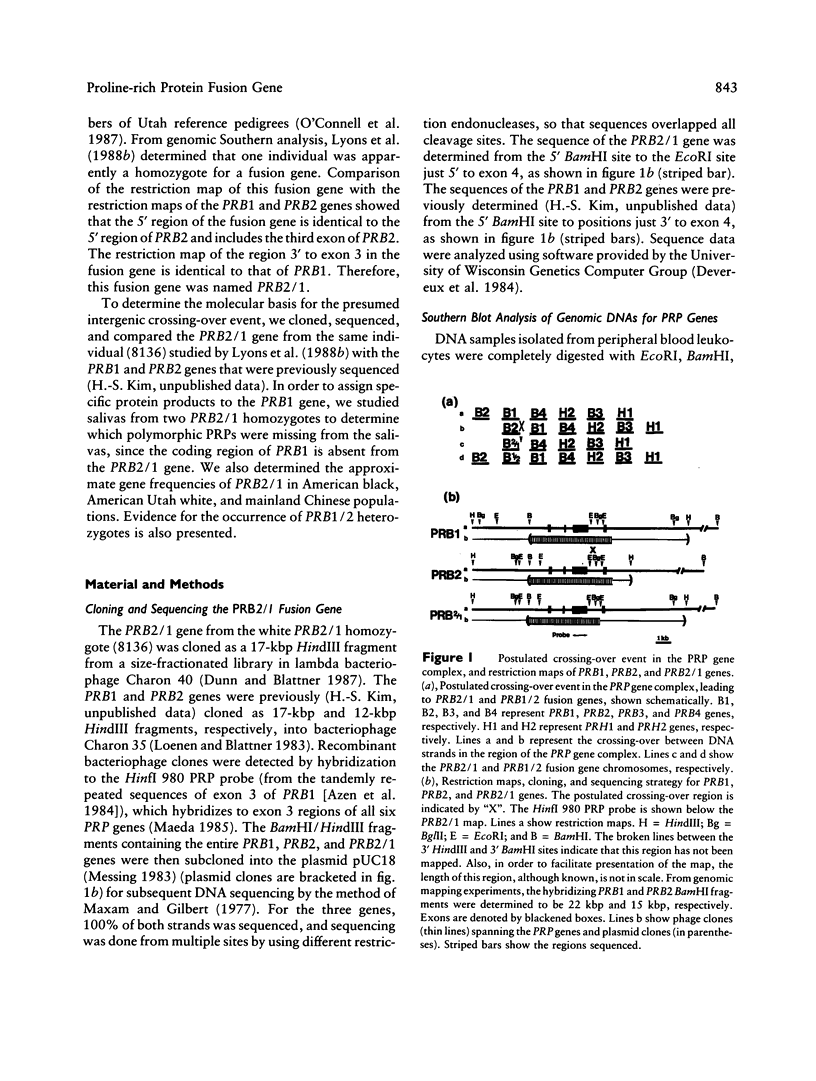

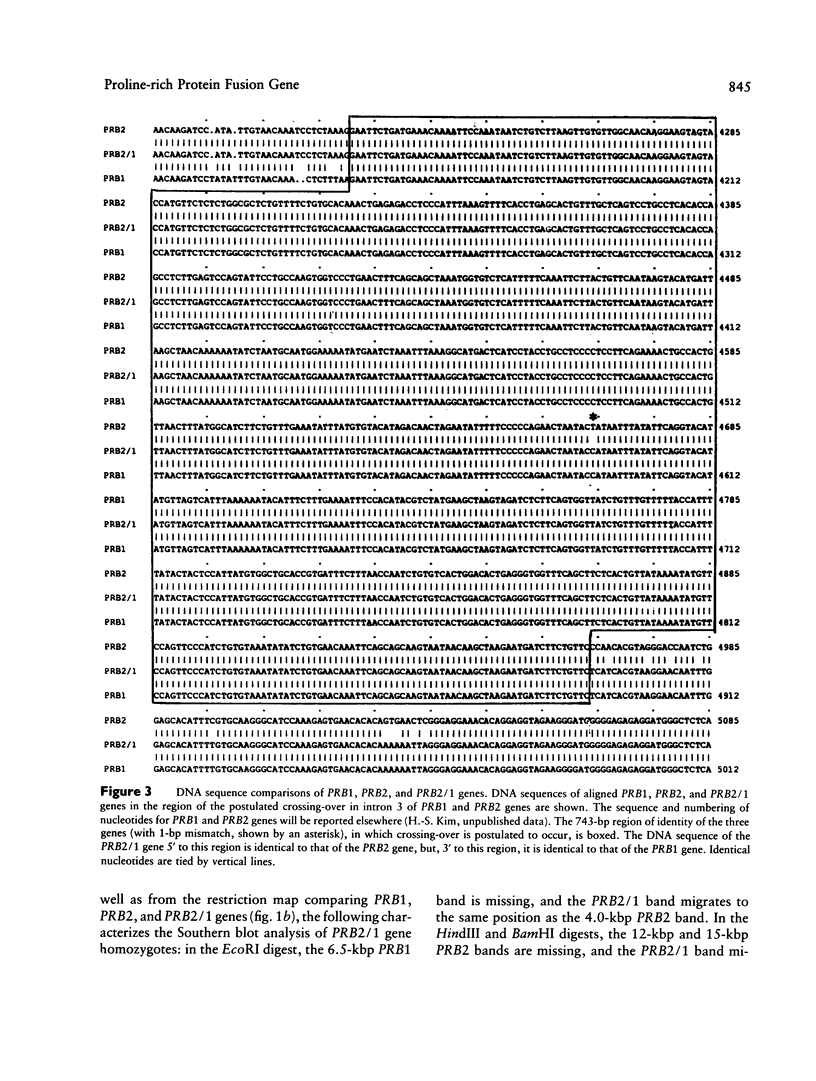
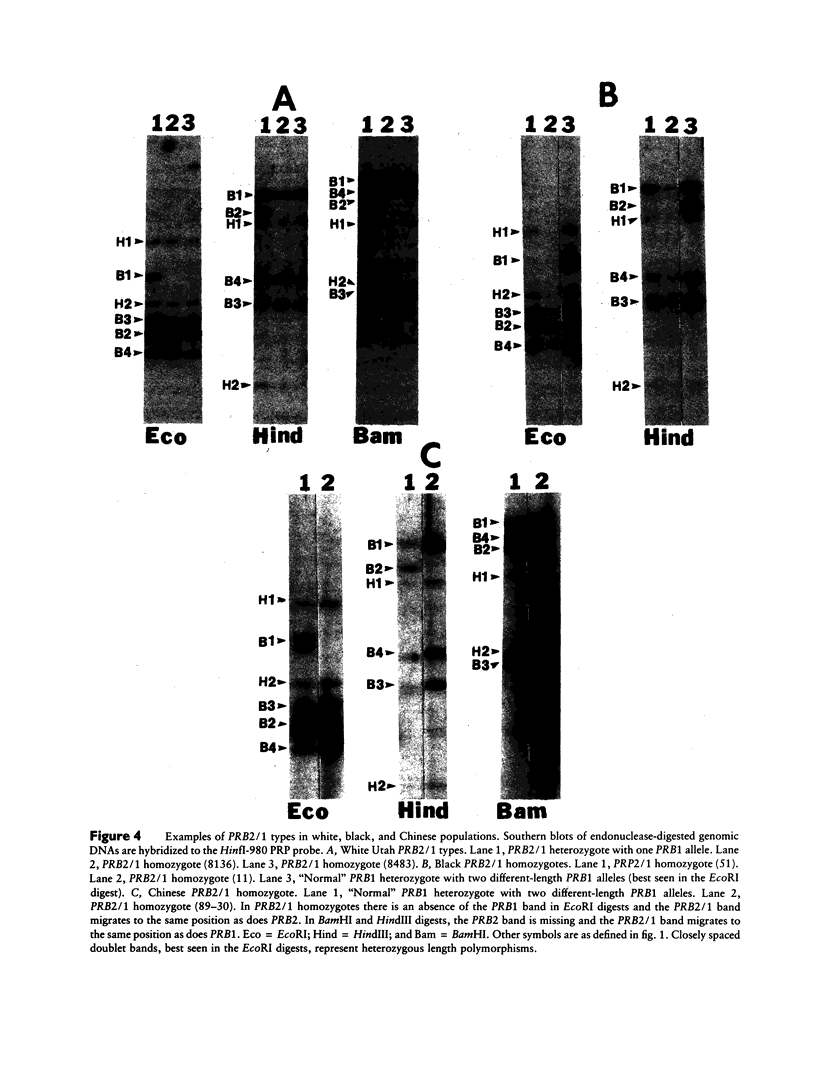


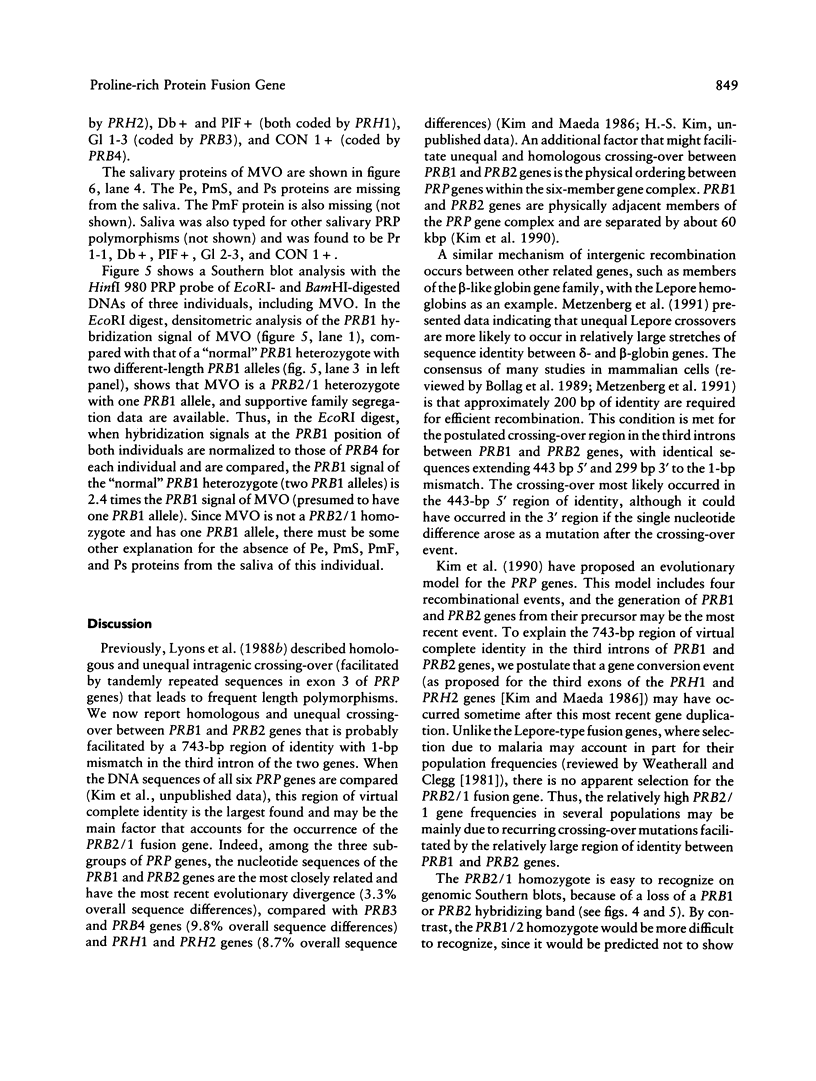
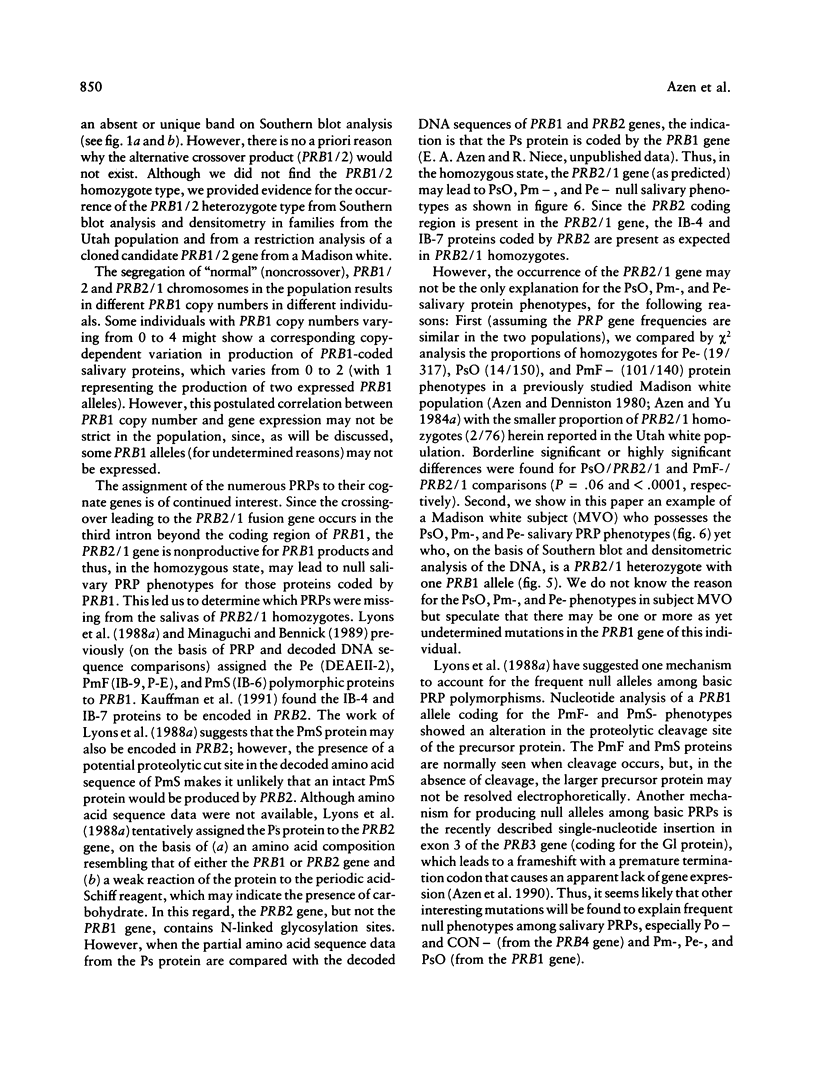
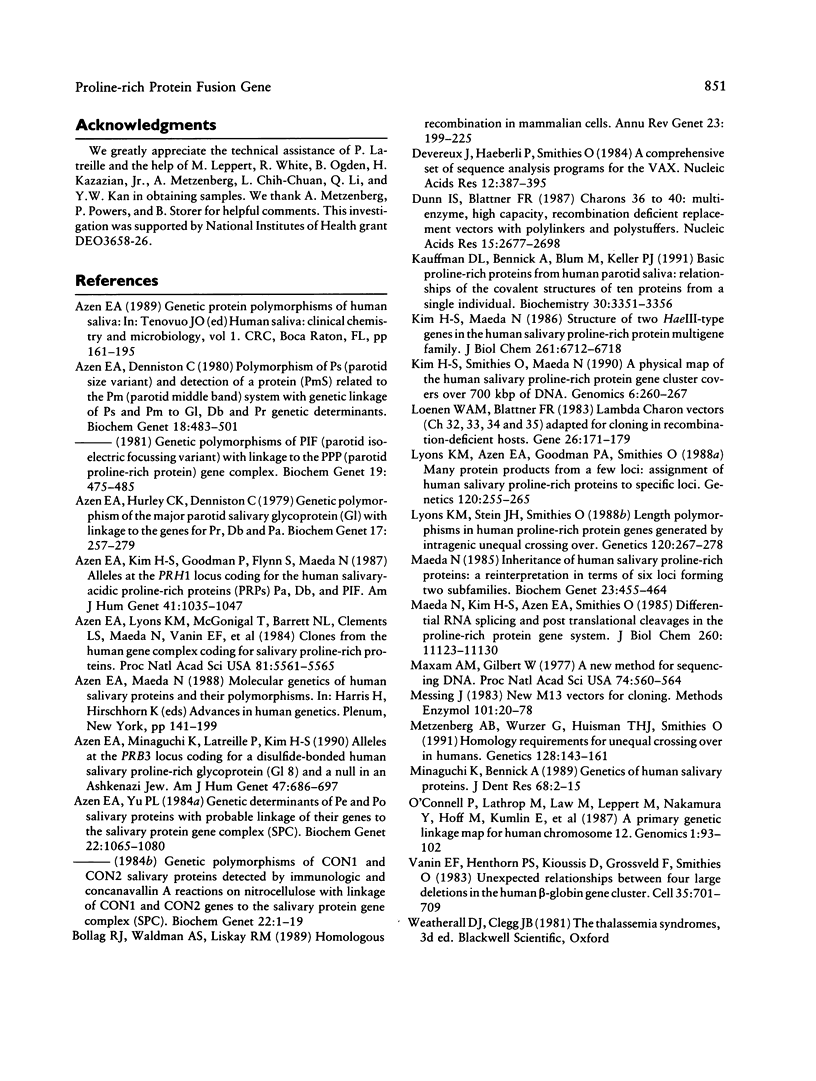
Images in this article
Selected References
These references are in PubMed. This may not be the complete list of references from this article.
- Azen E. A., Denniston C. Polymorphism of Ps (parotid size variant) and detection of a protein (PmS) related to the Pm (parotid middle band) system with genetic linkage of Ps and Pm to Gl, Db, and Pr genetic determinants. Biochem Genet. 1980 Jun;18(5-6):483–501. doi: 10.1007/BF00484396. [DOI] [PubMed] [Google Scholar]
- Azen E. A., Hurley C. K., Denniston C. Genetic polymorphism of the major parotid salivary glycoprotein (Gl) with linkage to the genes for Pr, Db, and Pa. Biochem Genet. 1979 Apr;17(3-4):257–279. doi: 10.1007/BF00498967. [DOI] [PubMed] [Google Scholar]
- Azen E. A., Kim H. S., Goodman P., Flynn S., Maeda N. Alleles at the PRH1 locus coding for the human salivary-acidic proline-rich proteins Pa, Db, and PIF. Am J Hum Genet. 1987 Dec;41(6):1035–1047. [PMC free article] [PubMed] [Google Scholar]
- Azen E. A., Maeda N. Molecular genetics of human salivary proteins and their polymorphisms. Adv Hum Genet. 1988;17:141–199. doi: 10.1007/978-1-4613-0987-1_5. [DOI] [PubMed] [Google Scholar]
- Azen E. A., Minaguchi K., Latreille P., Kim H. S. Alleles at the PRB3 locus coding for a disulfide-bonded human salivary proline-rich glycoprotein (Gl 8) and a null in an Ashkenazi Jew. Am J Hum Genet. 1990 Oct;47(4):686–697. [PMC free article] [PubMed] [Google Scholar]
- Azen E. A., Yu P. L. Genetic polymorphisms of Pe and Po salivary proteins with probable linkage of their genes to the salivary protein gene complex (SPC). Biochem Genet. 1984 Dec;22(11-12):1065–1080. doi: 10.1007/BF00499632. [DOI] [PubMed] [Google Scholar]
- Azen E., Lyons K. M., McGonigal T., Barrett N. L., Clements L. S., Maeda N., Vanin E. F., Carlson D. M., Smithies O. Clones from the human gene complex coding for salivary proline-rich proteins. Proc Natl Acad Sci U S A. 1984 Sep;81(17):5561–5565. doi: 10.1073/pnas.81.17.5561. [DOI] [PMC free article] [PubMed] [Google Scholar]
- Bollag R. J., Waldman A. S., Liskay R. M. Homologous recombination in mammalian cells. Annu Rev Genet. 1989;23:199–225. doi: 10.1146/annurev.ge.23.120189.001215. [DOI] [PubMed] [Google Scholar]
- Devereux J., Haeberli P., Smithies O. A comprehensive set of sequence analysis programs for the VAX. Nucleic Acids Res. 1984 Jan 11;12(1 Pt 1):387–395. doi: 10.1093/nar/12.1part1.387. [DOI] [PMC free article] [PubMed] [Google Scholar]
- Dunn I. S., Blattner F. R. Charons 36 to 40: multi enzyme, high capacity, recombination deficient replacement vectors with polylinkers and polystuffers. Nucleic Acids Res. 1987 Mar 25;15(6):2677–2698. doi: 10.1093/nar/15.6.2677. [DOI] [PMC free article] [PubMed] [Google Scholar]
- Kauffman D. L., Bennick A., Blum M., Keller P. J. Basic proline-rich proteins from human parotid saliva: relationships of the covalent structures of ten proteins from a single individual. Biochemistry. 1991 Apr 9;30(14):3351–3356. doi: 10.1021/bi00228a001. [DOI] [PubMed] [Google Scholar]
- Kim H. S., Maeda N. Structures of two HaeIII-type genes in the human salivary proline-rich protein multigene family. J Biol Chem. 1986 May 25;261(15):6712–6718. [PubMed] [Google Scholar]
- Kim H. S., Smithies O., Maeda N. A physical map of the human salivary proline-rich protein gene cluster covers over 700 kbp of DNA. Genomics. 1990 Feb;6(2):260–267. doi: 10.1016/0888-7543(90)90565-c. [DOI] [PubMed] [Google Scholar]
- Loenen W. A., Blattner F. R. Lambda Charon vectors (Ch32, 33, 34 and 35) adapted for DNA cloning in recombination-deficient hosts. Gene. 1983 Dec;26(2-3):171–179. doi: 10.1016/0378-1119(83)90187-7. [DOI] [PubMed] [Google Scholar]
- Lyons K. M., Azen E. A., Goodman P. A., Smithies O. Many protein products from a few loci: assignment of human salivary proline-rich proteins to specific loci. Genetics. 1988 Sep;120(1):255–265. doi: 10.1093/genetics/120.1.255. [DOI] [PMC free article] [PubMed] [Google Scholar]
- Maeda N. Inheritance of the human salivary proline-rich proteins: a reinterpretation in terms of six loci forming two subfamilies. Biochem Genet. 1985 Jun;23(5-6):455–464. doi: 10.1007/BF00499086. [DOI] [PubMed] [Google Scholar]
- Maeda N., Kim H. S., Azen E. A., Smithies O. Differential RNA splicing and post-translational cleavages in the human salivary proline-rich protein gene system. J Biol Chem. 1985 Sep 15;260(20):11123–11130. [PubMed] [Google Scholar]
- Maxam A. M., Gilbert W. A new method for sequencing DNA. Proc Natl Acad Sci U S A. 1977 Feb;74(2):560–564. doi: 10.1073/pnas.74.2.560. [DOI] [PMC free article] [PubMed] [Google Scholar]
- Messing J. New M13 vectors for cloning. Methods Enzymol. 1983;101:20–78. doi: 10.1016/0076-6879(83)01005-8. [DOI] [PubMed] [Google Scholar]
- Metzenberg A. B., Wurzer G., Huisman T. H., Smithies O. Homology requirements for unequal crossing over in humans. Genetics. 1991 May;128(1):143–161. doi: 10.1093/genetics/128.1.143. [DOI] [PMC free article] [PubMed] [Google Scholar]
- Minaguchi K., Bennick A. Genetics of human salivary proteins. J Dent Res. 1989 Jan;68(1):2–15. doi: 10.1177/00220345890680010201. [DOI] [PubMed] [Google Scholar]
- O'Connell P., Lathrop G. M., Law M., Leppert M., Nakamura Y., Hoff M., Kumlin E., Thomas W., Elsner T., Ballard L. A primary genetic linkage map for human chromosome 12. Genomics. 1987 Sep;1(1):93–102. doi: 10.1016/0888-7543(87)90110-8. [DOI] [PubMed] [Google Scholar]
- Vanin E. F., Henthorn P. S., Kioussis D., Grosveld F., Smithies O. Unexpected relationships between four large deletions in the human beta-globin gene cluster. Cell. 1983 Dec;35(3 Pt 2):701–709. doi: 10.1016/0092-8674(83)90103-4. [DOI] [PubMed] [Google Scholar]



